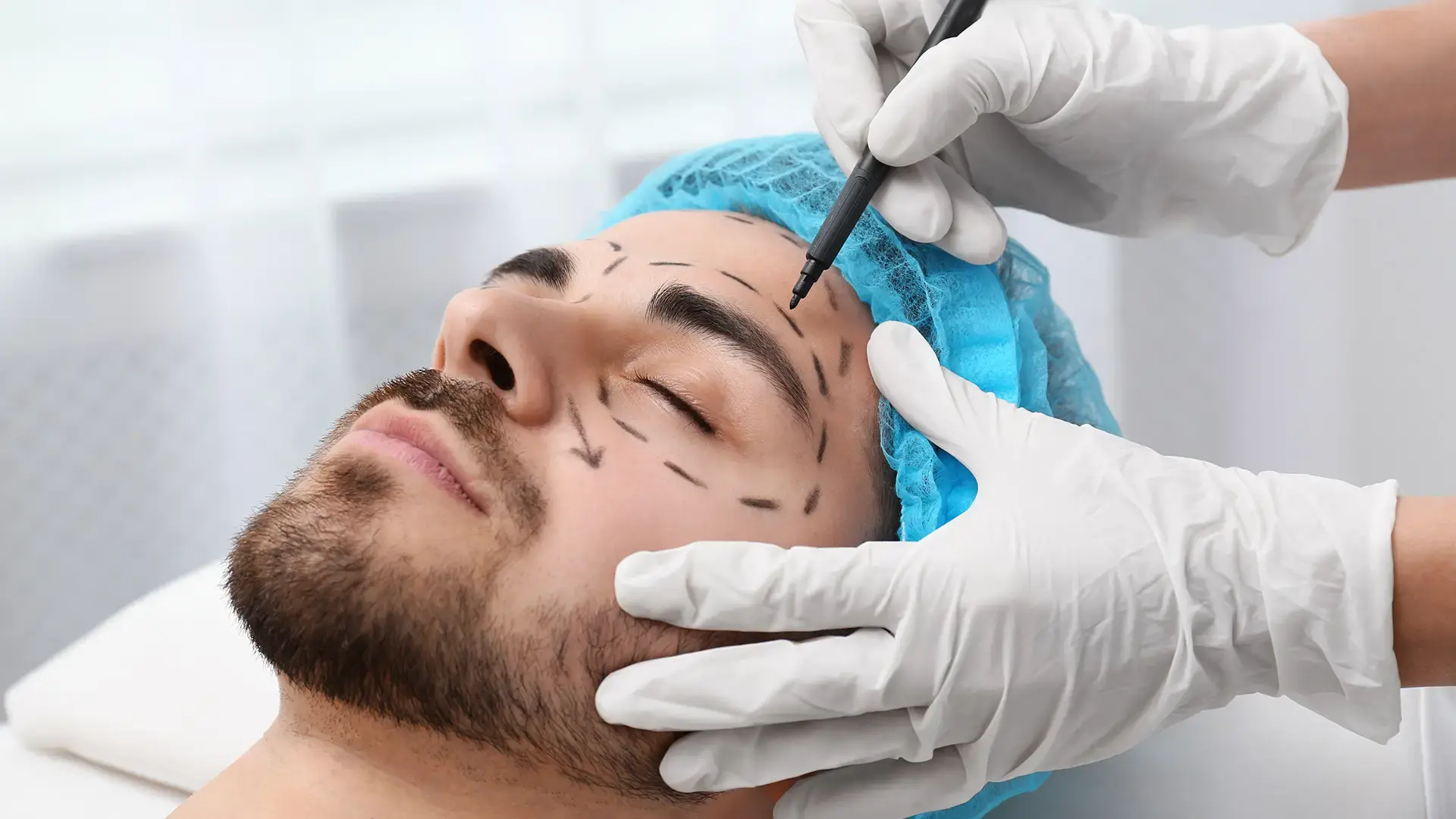What Is Facial Masculinization Surgery?

Facial masculinization surgery (FMS) is a set of procedures designed to enhance masculine facial features for males or individuals who may be transitioning from female to male (FTM). Procedures such as brow bone augmentation, jaw contouring, and chin augmentation are often performed to create a more masculine facial structure.
The goal of FMS is to align facial features with the desired masculine appearance, helping the individual achieve a more masculine or androgynous gender expression. It is crucial to consult with experienced specialists in this field, as they evaluate each patient's unique facial structure and recommend the most appropriate combination of procedures to achieve the desired outcome. FMS can be a transformative step in the transition process, contributing to your overall well-being and self-confidence.
Different Types of FMS Procedures
There is a range of surgical options available for people who wish to masculinize certain parts of their face. It is important to note not all patients require or desire every procedure, and the specific combination of procedures will depend on the individual's facial features. Additionally, these procedures should be performed by qualified surgeons who specialize in facial surgery to ensure the best possible results and minimize potential risks or complications.- Chin augmentation (Genioplasty): This procedure involves surgically enhancing the size and projection of the chin, often using implants or bone grafts, to create a more prominent, masculine chin profile.
- Rhinoplasty: Also known as a "nose job," this surgery can reshape the nose to achieve a more masculine appearance, such as straightening the nasal bridge, reshaping the nasal tip, or adjusting the overall size and projection of the nose.
- Jaw contouring or jaw implants: These procedures can enhance the jawline and create a more angular, chiseled look. Jaw contouring may involve reshaping the jawbone through surgery or using implants to augment the jawline.
- Brow bone augmentation or forehead contouring: These procedures can increase the projection and masculinize the appearance of the brow ridge and forehead area, often using implants or bone grafts.
- Cheek augmentation or malar implants: Implants or fillers can be used to enhance the prominence and definition of the cheekbones, creating a more masculine facial contour.
What to Expect From Facial Masculinization Surgery
Facial masculinization surgeries are typically invasive procedures that require careful planning and preparation. Depending on the specific procedures being performed, patients can expect to undergo general anesthesia and potentially have an overnight hospital stay. The surgeries themselves can involve making incisions, reshaping bone structures, and placing implants or grafts.
The recovery process varies based on the extent of the surgeries performed. Patients may expect significant swelling, bruising, and discomfort in the initial weeks following the procedures. It is common to experience tightness, temporary numbness, or tingling sensations as the facial tissues heal. Strict adherence to post-operative instructions, such as avoiding strenuous activities, following wound care protocols, and attending follow-up appointments, is crucial for proper healing and minimizing risks of complications.
Most patients require several weeks to fully recover, with the swelling and bruising gradually subsiding over time. During this period, it is important to be patient and understand the final results may not be immediately apparent. Temporary dietary modifications, such as consuming liquids, soft foods or using straws, may be necessary. Pain medication and cold compresses can help manage discomfort. It is also essential to plan for time off work or other commitments to prioritize rest and recovery. While the journey can be challenging, following the surgeon's guidance and allowing adequate healing time can help ensure a successful outcome.
Results of Facial Masculinization
Patients undergoing facial masculinization surgeries can realistically expect significant changes to their facial features that enhance masculine characteristics. However, the degree of transformation will vary from person to person based on their unique facial structure and the specific procedures performed. While these procedures can significantly masculinize the face, the results may not align with idealized or exaggerated masculine features seen in media or popular culture. The goal is to achieve a natural, harmonious, and gender-congruent appearance that aligns with the patient's desired outcome.
It is also crucial to have realistic expectations regarding the healing process and recognize the final results may take several months to fully appreciate as swelling subsides and the tissues settle into their new contours.
Benefits of FMS
Facial masculinization surgery offers several significant benefits for transgender men and non-binary individuals seeking to align their facial features with their gender identity. Some key benefits include:- Accurate gender expression: These procedures can help create facial characteristics that better reflect the patient's experienced gender, promoting a greater sense of alignment between their physical appearance and internal gender identity.
- Improved self-confidence and well-being: By achieving a more masculine facial appearance, many individuals report feeling more comfortable and confident in their own skin, which can positively impact their overall mental health and quality of life.
- Social affirmation: Facial masculinization can help individuals present themselves to the world in a way that is consistent with their gender identity, reducing potential misgendering or discrimination in social and professional settings.
- Alleviation of gender dysphoria: For those experiencing gender dysphoria related to their facial features, masculinization procedures can help alleviate this distress by bringing their physical appearance into greater harmony with their internal sense of self.
- Improved self-perception: By creating a facial appearance that better aligns with their gender identity, individuals may experience a more positive self-perception, which can have far-reaching benefits for their self-esteem and overall well-being.
- Complementing other transition procedures: Facial masculinization surgery can complement other gender-affirming treatments or procedures, such as hormone therapy or chest masculinization, providing a more comprehensive and holistic approach to gender transition.
Risks
Like any surgical procedure, facial masculinization surgery carries certain risks that patients should be aware of before undergoing these treatments. Be sure to have a detailed discussion with your surgeon about your individual risk factors based on your medical history and the specific procedures being performed. Some of the potential risks and complications include:- Infection: As with any invasive surgery, there is a risk of developing infections at the surgical sites or elsewhere in the body. Proper wound care and adherence to post-operative instructions can help minimize this risk.
- Bleeding and hematoma: Excessive bleeding during or after the surgery can lead to the formation of hematomas (collections of blood) under the skin, which may require drainage or additional procedures.
- Nerve damage: Depending on the specific procedures performed, there is a risk of temporary or permanent nerve damage, which can result in numbness, tingling, or loss of sensation in certain areas of the face.
- Scarring: While efforts are made to minimize visible scarring, some level of scarring is inevitable, especially in areas where incisions are made, such as under the chin or around the hairline.
- Implant complications: For procedures involving implants, there is a risk of implant rejection, migration, or infection, which may necessitate additional surgeries for removal or replacement.
- Asymmetry or unsatisfactory results: Despite the surgeon's best efforts, there is a possibility the desired level of symmetry or masculinization may not be achieved, potentially requiring revision surgeries.
- Anesthesia risks: As with any surgery requiring general anesthesia, there are inherent risks associated with the anesthesia itself, such as adverse reactions or potential complications.
- Prolonged swelling or bruising: Some patients may experience prolonged swelling or bruising, which can delay the final outcome and recovery process.
Who Is a Good Candidate for Facial Masculinization Surgery
It is important for potential candidates to undergo a comprehensive evaluation by a qualified medical team, potentially including mental health professionals, to assess their suitability for facial masculinization surgery. Facial masculinization surgery can be a suitable option for individuals who meet certain criteria. A good candidate for these procedures typically exhibits the following characteristics:- Transgender men or non-binary individuals: Those who were assigned female at birth but identify as male or non-binary and wish to achieve a more masculine facial appearance are often ideal candidates for facial masculinization surgery.
- Persistent gender dysphoria: Individuals who experience significant and persistent gender dysphoria related to their facial features may find relief and improved well-being through these procedures.
- Realistic expectations: It is essential for candidates to have a clear understanding of the potential outcomes, limitations, and recovery processes associated with these surgeries, and to have realistic expectations about the results.
- Emotional and psychological readiness: Candidates should be emotionally and psychologically prepared for the surgical process, as well as the potential social implications of their transition.
- Good physical health: Candidates should generally be in good overall physical health, without any significant medical conditions that could increase surgical risks or impair healing.
- Stable mental health: A stable mental health condition and the ability to provide informed consent are essential considerations for candidates.
- Age and maturity: While there is no strict age requirement, candidates should be of legal age and demonstrate the necessary maturity to understand and consent to the procedures.
- Support system: Having a solid support system in place, such as family, friends, or support groups, can be beneficial during the recovery and transition process.
Choosing the Best Surgeon for You: Schedule Your Consultation Today!
Embark on your journey toward achieving the facial features you have always envisioned at The Plastic Surgery Center, a premier destination for gender-affirming surgery. Our renowned team of highly skilled New Jersey plastic surgeons specializes in delivering exceptional results that align with your unique goals and identity.
With a comprehensive understanding of facial masculinization techniques and a commitment to personalized care, we will guide you through every step of the process, ensuring a seamless and transformative experience. Schedule a consultation today!
###
ABOUT THE BREAST CENTER OF NEW JERSEY
The Breast Center of New Jersey brings together world-renowned specialists across breast cancer prevention, diagnosis, and treatment disciplines to simplify, streamline, and improve access to life-changing care. Visit BCNJ.com to learn more about The Breast Center of New Jersey. Call 833-200-4009 to make an appointment.
Awards, Certificates, & Associations

